Effects of Supercritical CO2 on Matrix Permeability of Unconventional Formations
Abstract
:1. Introduction
2. Materials and Methods
2.1. Samples
2.2. Experimental Procedure
2.3. Experimental Program
2.4. Permeability Measurement
2.5. Imaging
3. Results and Data Analysis
3.1. Mineral Dissolution
3.1.1. Sample 2-1H; Ultralow-Permeability, Carbonate-Rich
3.1.2. Sample 4-2H; High-Permeability, Carbonate-Poor
3.2. Adsorption into Clays and Organic Matter
3.2.1. Sample 4-4H; High “Clay + TOC”; Regular Cycles
3.2.2. Sample 3-2H; Extended Cycles
3.3. Competition between Dissolution and Adsorption
3.3.1. Samples 1-63H and 3-110H; Shorter-Term Experiment; Combined Effects
3.3.2. Sample 1-42-3H; Longer-Term Experiment
3.4. Sample 4-6H; Matrix Weakening
4. Discussions
4.1. Control of Initial (Unreacted) Argon Permeability by Carbonate Content
4.2. Argon vs. scCO2 Permeability
4.3. Competing Effects of Dissolution and Adsorption
4.4. Micro-Structural Changes
4.5. Pressure-Dependency
5. Conclusions
Author Contributions
Funding
Institutional Review Board Statement
Informed Consent Statement
Data Availability Statement
Acknowledgments
Conflicts of Interest
References
- IEA Report. Exploring Clean Energy Pathways: The Role of CO2 Storage. 2019. Available online: https://www.iea.org/reports/the-role-of-co2-storage (accessed on 12 April 2020).
- NETL Report. Carbon Sequestration Atlas of the United States and Canada, Fifth ed. National Energy Technology Laboratory; U.S. Department of Energy, 2015. Available online: https://www.netl.doe.gov/sites/default/files/2018-10/ATLAS-V-2015.pdf (accessed on 28 September 2020).
- Kang, S.M.; Fathi, E.; Ambrose, R.J.; Akkutlu, I.Y.; Sigal, R.F. Carbon dioxide storage capacity of organic-rich shales. SPE J. 2011, 16, 842–855. [Google Scholar] [CrossRef] [Green Version]
- Jin, L.; Hawthorne, S.; Sorensen, J.; Pekot, L.; Kurz, B.; Smith, S.; Heebink, L.; Herdegen, V.; Bosshart, N.; Torres, J.; et al. Advancing CO2 enhanced oil recovery and storage in unconventional oil play—experimental studies on Bakken shales. Appl. Energy 2017, 208, 171–183. [Google Scholar] [CrossRef]
- Middleton, R.S.; Carey, J.W.; Currier, R.P.; Hyman, J.D.; Kang, Q.; Karra, S.; Jiménez-Martínez, J.; Porter, M.L.; Viswanathan, H.S. Shale gas and non-aqueous fracturing fluids: Opportunities and challenges for supercritical CO2. Appl. Energy 2015, 147, 500–509. [Google Scholar] [CrossRef] [Green Version]
- Jia, B.; Tsau, J.S.; Barati, R. A review of the current progress of CO2 injection EOR and carbon storage in shale oil reservoirs. Fuel 2019, 236, 404–427. [Google Scholar] [CrossRef]
- Zoback, M.D.; Kovscek, A.R.; Wilcox, J. Interdisciplinary Investigation of CO2 Sequestration in Depleted Shale Gas Formations; The Leland Stanford Junior University: Stanford, CA, USA, 2013. [Google Scholar]
- Heller, R.; Vermylen, J.; Zoback, M. Experimental investigation of matrix permeability of gas shales. AAPG Bull. 2014, 98, 975–995. [Google Scholar] [CrossRef]
- Zoback, M.D.; Kohli, A.H. Unconventional Reservoir Geomechanics; Cambridge University Press: Cambridge, UK, 2019. [Google Scholar]
- Zhang, C.; Ranjith, P.G. Experimental study of matrix permeability of gas shale: An application to CO2-based shale fracturing. Energies 2018, 11, 702. [Google Scholar] [CrossRef] [Green Version]
- Yin, H.; Zhou, J.; Jiang, Y.; Xian, X.; Liu, Q. Physical and structural changes in shale associated with supercritical CO2 exposure. Fuel 2016, 184, 289–303. [Google Scholar] [CrossRef]
- Pan, Y.; Hui, D.; Luo, P.; Zhang, Y.; Zhang, L.; Sun, L. Influences of subcritical and supercritical CO2 treatment on the pore structure characteristics of marine and terrestrial shales. J. CO2 Util. 2018, 28, 152–167. [Google Scholar] [CrossRef]
- Pan, Y.; Hui, D.; Luo, P.; Zhang, Y.; Sun, L.; Wang, K. Experimental investigation of the geochemical interactions between supercritical CO2 and shale: Implications for CO2 storage in gas-bearing shale formations. Energy Fuels 2018, 32, 1963–1978. [Google Scholar] [CrossRef]
- Hadian, P.; Rezaee, R. The Effect of Supercritical CO2 on Shaly Caprocks. Energies 2020, 13, 149. [Google Scholar] [CrossRef] [Green Version]
- Rohmer, J.; Pluymakers, A.; Renard, F. Mechano-chemical interactions in sedimentary rocks in the context of CO2 storage: Weak acid, weak effects? Earth-Sci. Rev. 2016, 157, 86–110. [Google Scholar] [CrossRef]
- Lu, J.; Nicot, J.P.; Mickler, P.J.; Ribeiro, L.H.; Darvari, R. Alteration of Bakken reservoir rock during CO2-based fracturing—An autoclave reaction experiment. J. Unconv. Oil Gas Resour. 2016, 14, 72–85. [Google Scholar] [CrossRef]
- Sanguinito, S.; Goodman, A.; Tkach, M.; Kutchko, B.; Culp, J.; Natesakhawat, S.; Fazio, J.; Fukai, I.; Crandall, D. Quantifying dry supercritical CO2-induced changes of the Utica Shale. Fuel 2018, 226, 54–64. [Google Scholar] [CrossRef] [Green Version]
- Goodman, A.; Sanguinito, S.; Tkach, M.; Natesakhawat, S.; Kutchko, B.; Fazio, J.; Cvetic, P. Investigating the role of water on CO2-Utica Shale interactions for carbon storage and shale gas extraction activities–Evidence for pore scale alterations. Fuel 2019, 242, 744–755. [Google Scholar] [CrossRef]
- Kutchko, B.; Sanguinito, S.; Natesakhawat, S.; Cvetic, P.; Culp, J.T.; Goodman, A. Quantifying pore scale and matrix interactions of SCCO2 with the Marcellus shale. Fuel 2020, 266, 116928. [Google Scholar] [CrossRef]
- Heller, R.; Zoback, M. Adsorption of methane and carbon dioxide on gas shale and pure mineral samples. J. Unconv. Oil Gas Resour. 2014, 8, 14–24. [Google Scholar] [CrossRef] [Green Version]
- Lindner, E.N. Review of the Effects of CO2 on Very-Fine-Grained Sedimentary Rock/Shale–Part II: Clay Mineral & Shale Response to Hydration (No. 68913329-03d5-45bc-b32a-a7e8e763b10a); National Energy Technology Laboratory-Energy Data eXchange; NETL: 2016. Available online: https://www.osti.gov/scitech/search/filter-results:FD/semantic:10.18141/1432993 (accessed on 3 March 2020).
- Al Ismail, M.; Reece, J.S.; Hol, S.; Zoback, M. The effect of CO2 adsorption on permeability anisotropy in the Eagle Ford Shale. In Unconventional Resources Technology Conference (URTEC); 2014; Available online: https://onepetro.org/URTECONF/proceedings-abstract/14URTC/All-14URTC/URTEC-1921520-MS/151592 (accessed on 15 November 2019).
- Wu, W.; Zoback, M.D.; Kohli, A.H. The impacts of effective stress and CO2 sorption on the matrix permeability of shale reservoir rocks. Fuel 2017, 203, 179–186. [Google Scholar] [CrossRef]
- Klewiah, I.; Berawala, D.S.; Walker, H.C.A.; Andersen, P.Ø.; Nadeau, P.H. Review of experimental sorption studies of CO2 and CH4 in shales. J. Nat. Gas Sci. Eng. 2020, 73, 103045. [Google Scholar] [CrossRef]
- van Noort, R.; Yarushina, V. Water, CO2 and argon permeabilities of intact and fractured shale cores under stress. Rock Mech. Rock Eng. 2019, 52, 299–319. [Google Scholar] [CrossRef] [Green Version]
- Play, W.S. Permian Basin. 2018. Available online: https://www.eia.gov/maps/pdf/PermianBasin_Wolfcamp_EIAReport_Oct2018.pdf (accessed on 24 May 2020).
- Scheidegger, A.E. The Physics of Flow through Porous Media, 3rd ed.; University of Toronto Press: Toronto, ON, Canada, 1974. [Google Scholar]
- Brace, W.; Walsh, J.B.; Frangos, W.T. Permeability of granite under high pressure. J. Geophys. Res. 1968, 73, 2225–2236. [Google Scholar] [CrossRef]
- Metwally, Y.M.; Sondergeld, C.H. Measuring low permeabilities of gas-sands and shales using a pressure transmission technique. Int. J. Rock Mech. Min. Sci. 2011, 48, 1135–1144. [Google Scholar] [CrossRef]
- Einsele, G. Sedimentary Basins: Evolution, Facies, and Sediment Budget; Springer Science & Business Media: Berlin/Heidelberg, Germany, 2000. [Google Scholar]
- Kamali-Asl, A.; Ghazanfari, E.; Newell, P.; Stevens, M. Elastic, viscoelastic, and strength properties of Marcellus Shale specimens. J. Pet. Sci. Eng. 2018, 171, 662–679. [Google Scholar] [CrossRef]

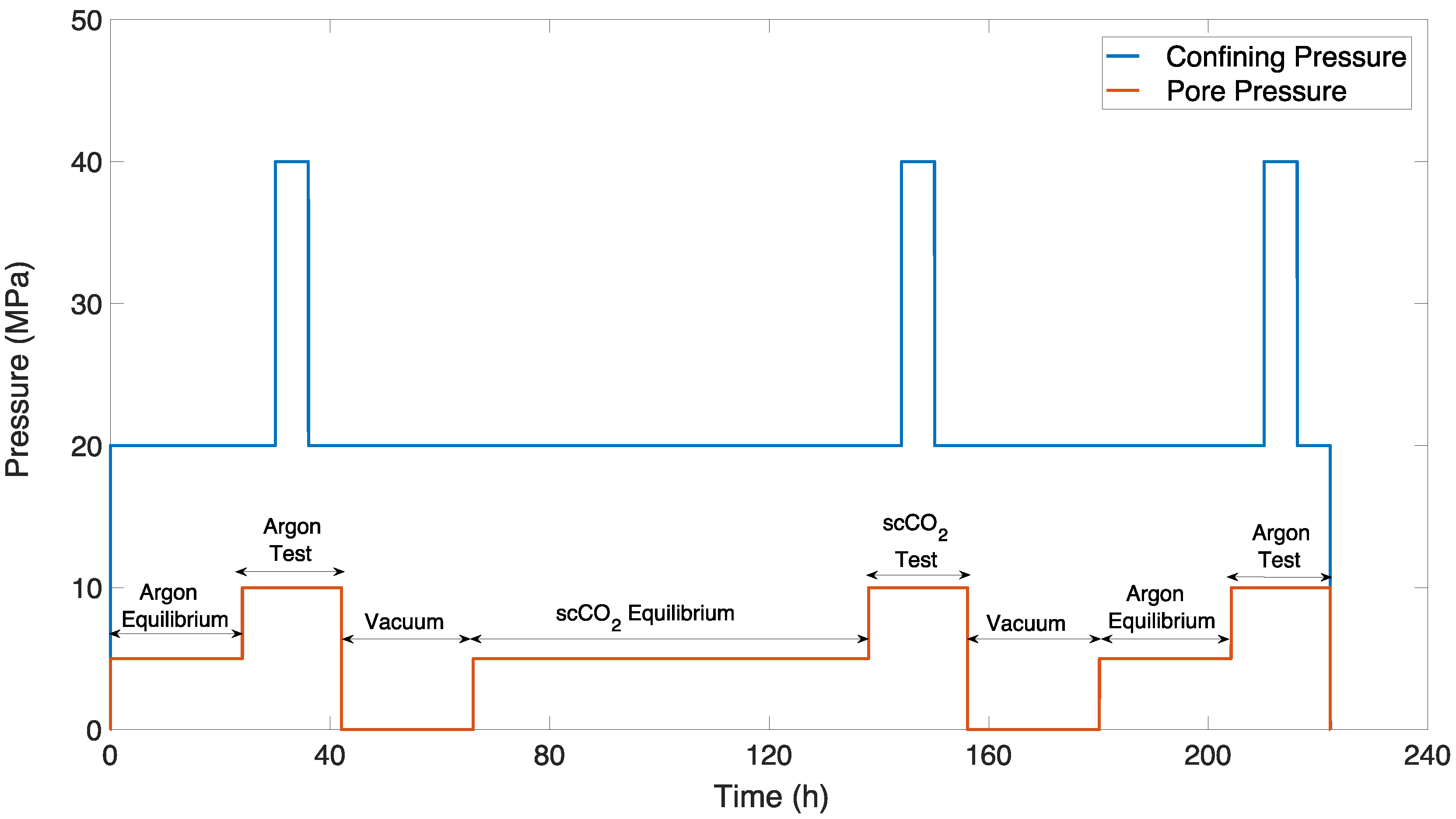
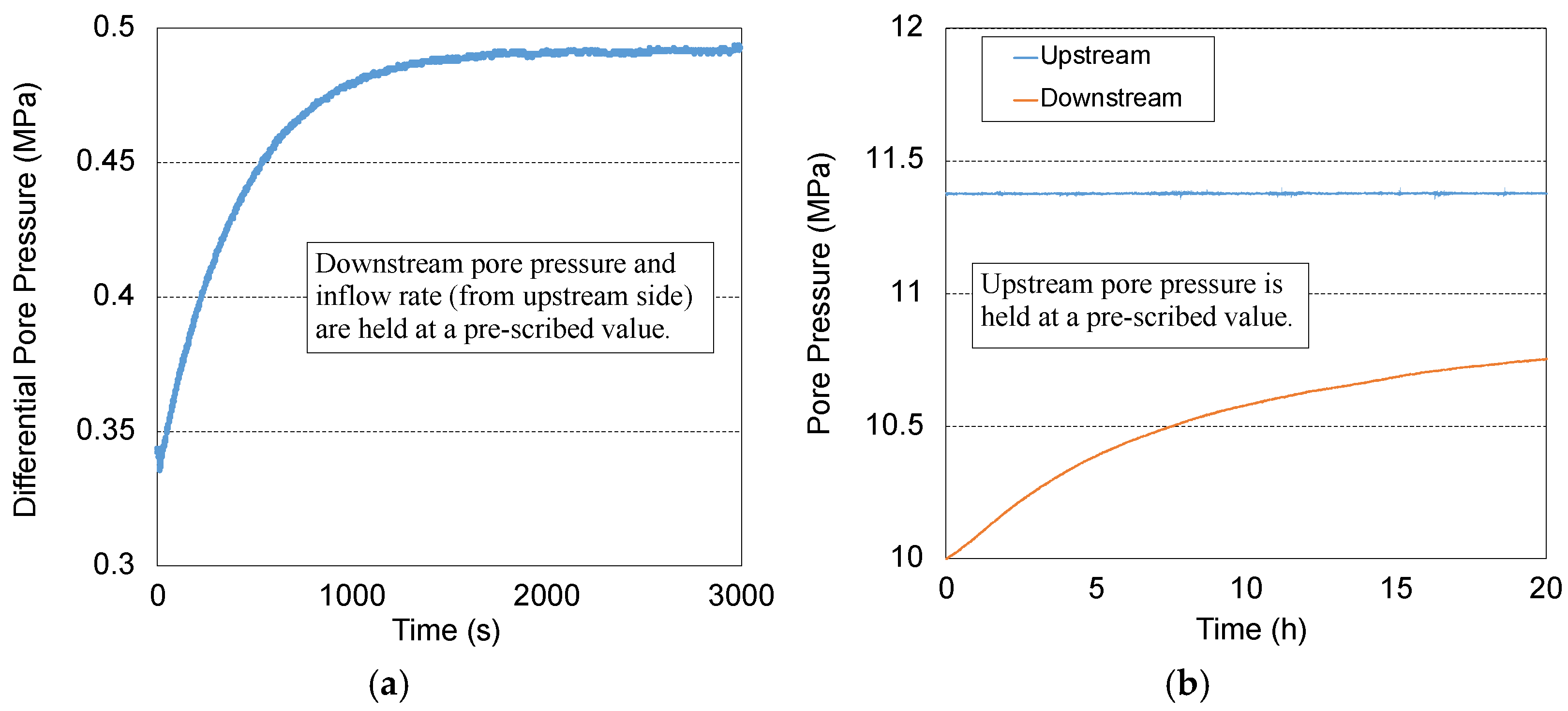

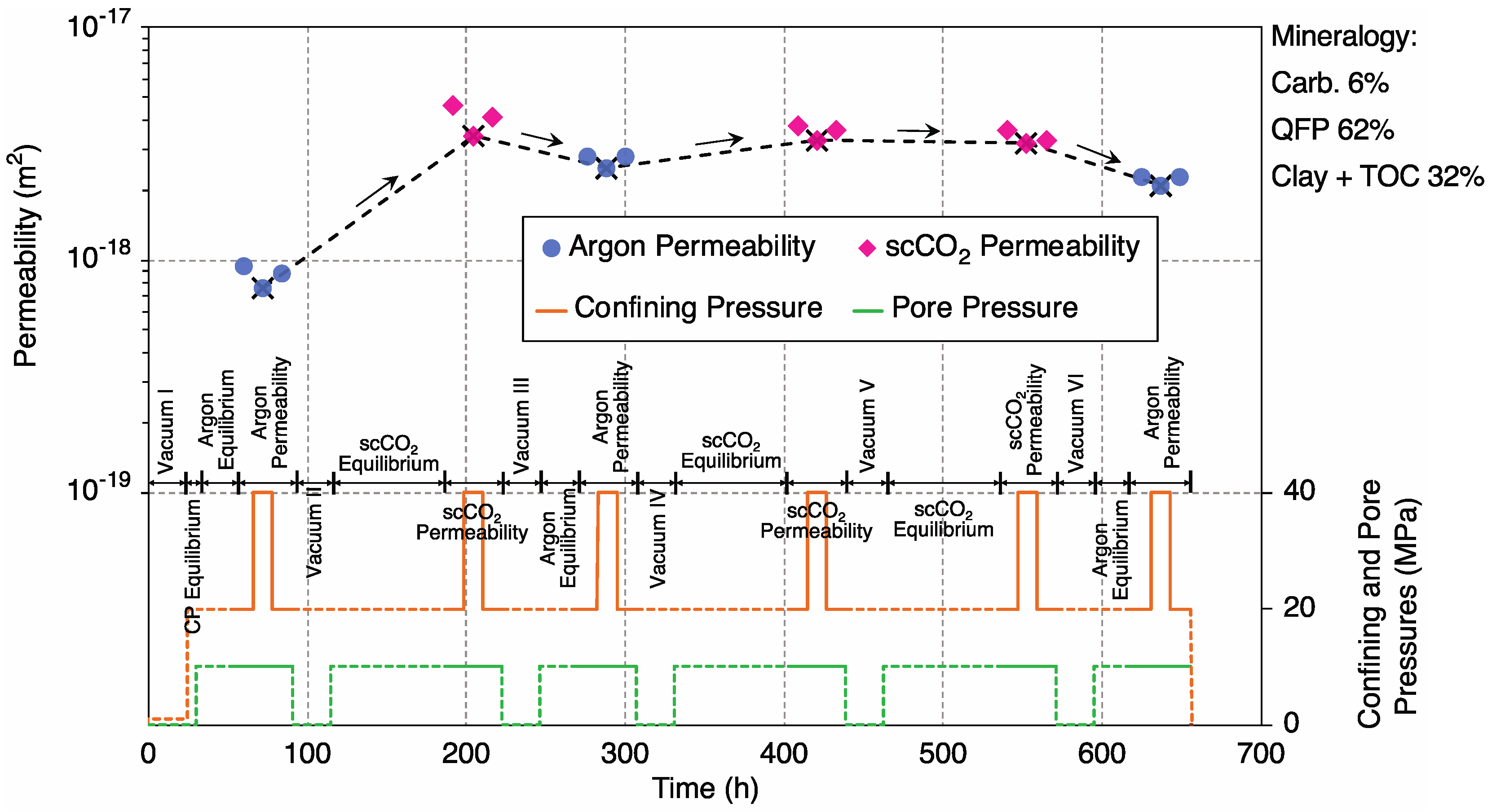
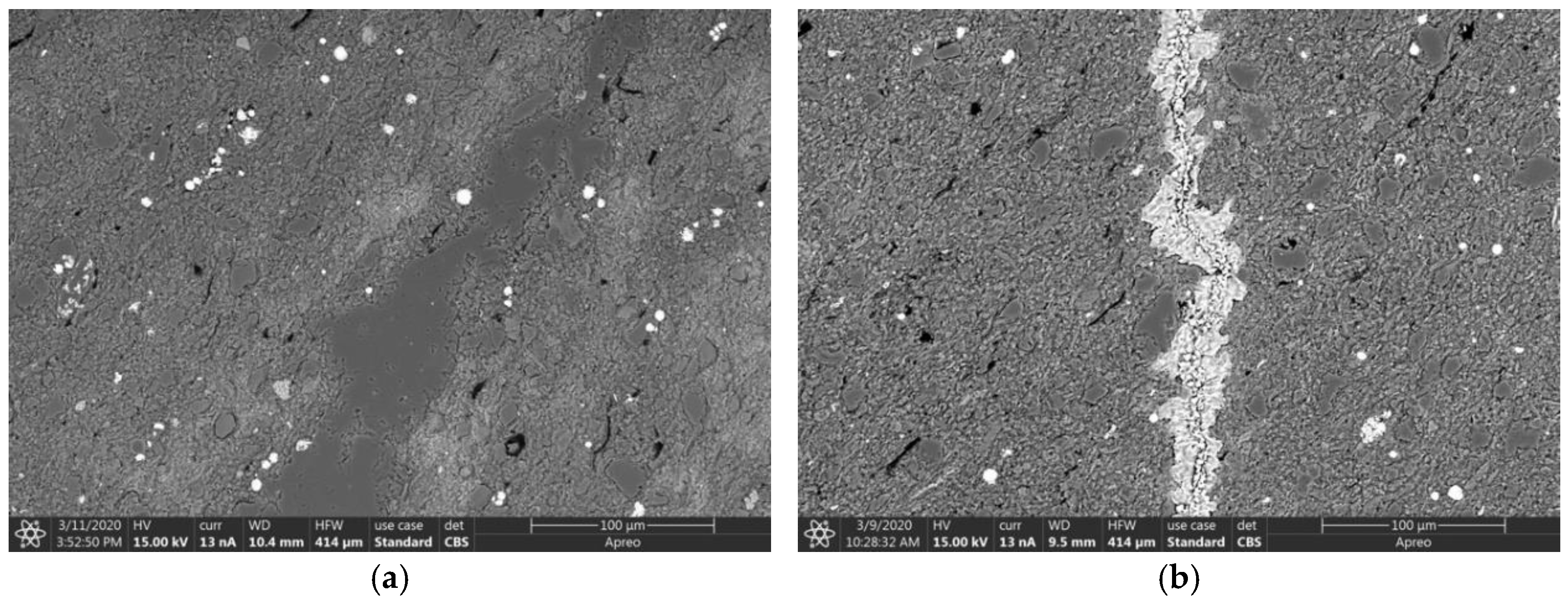
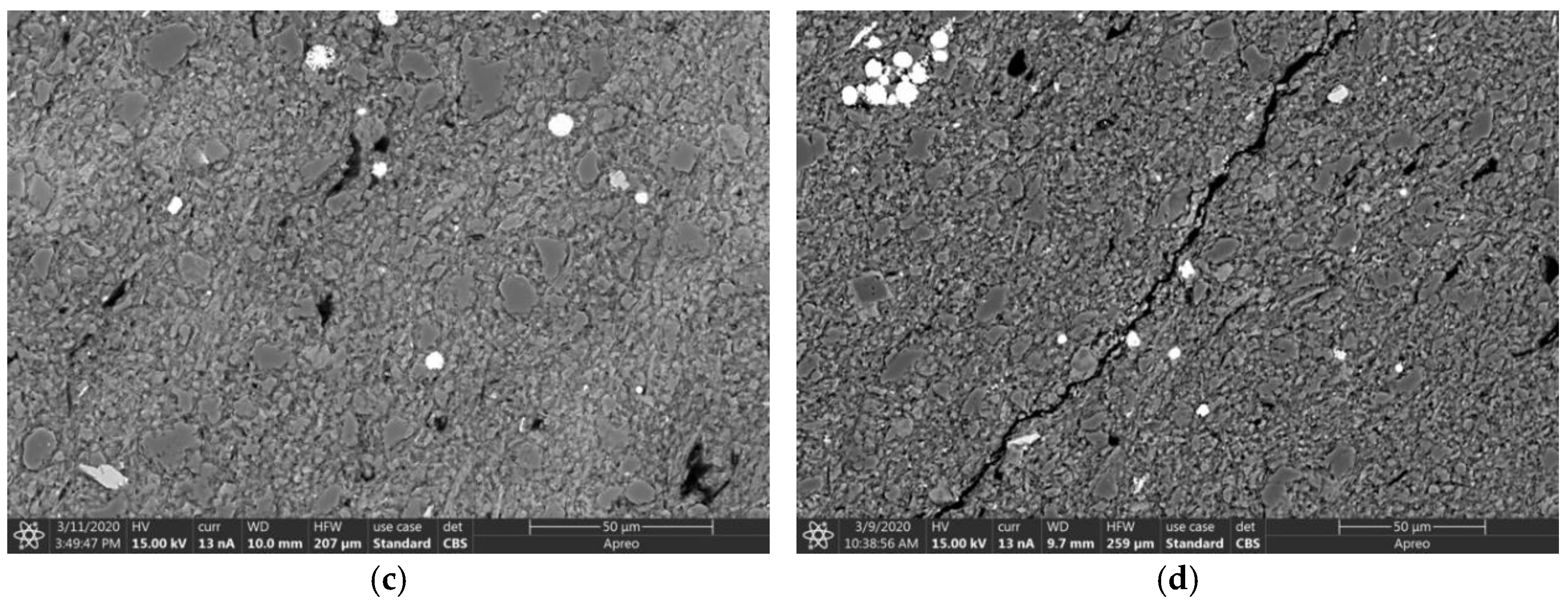

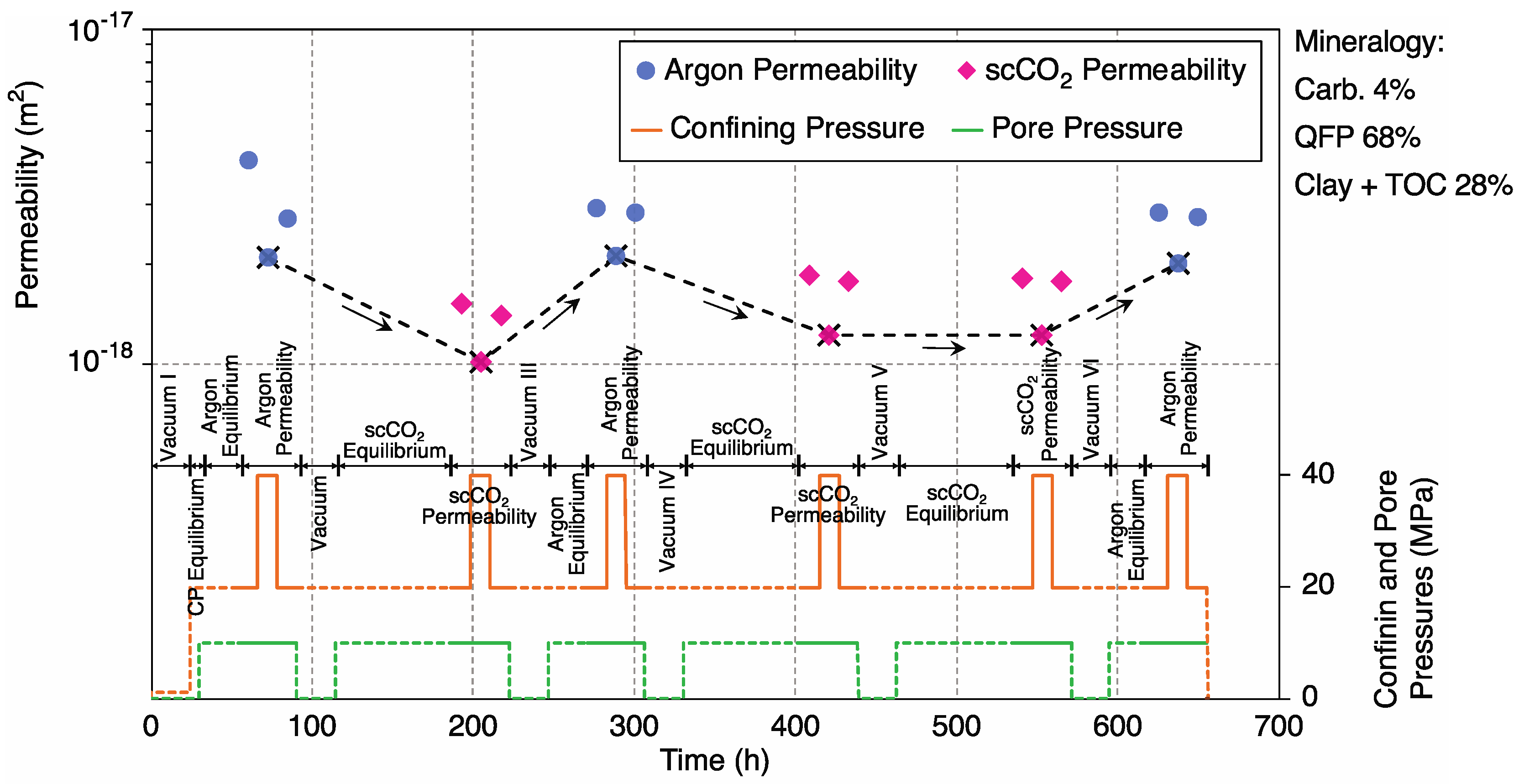

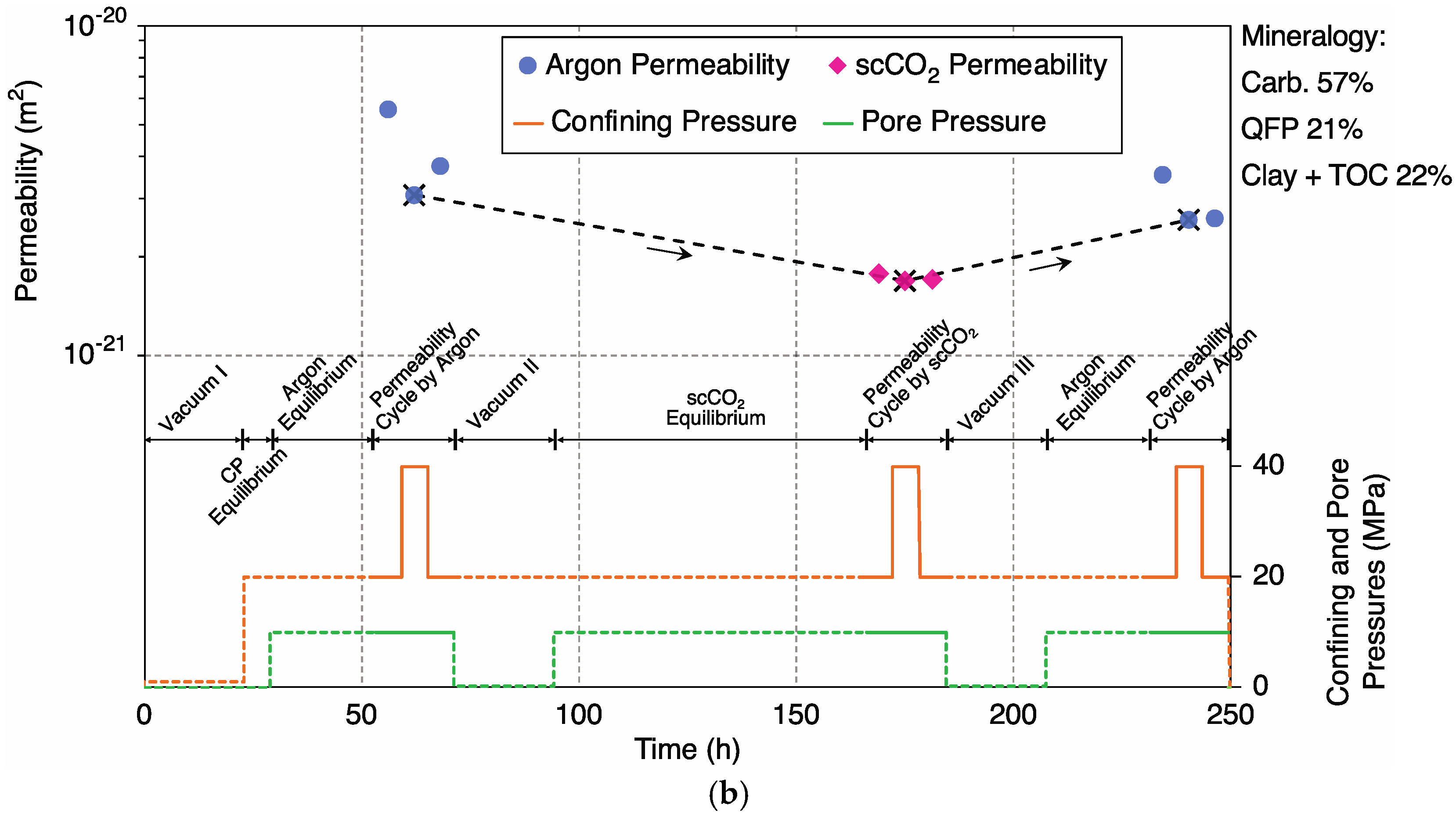

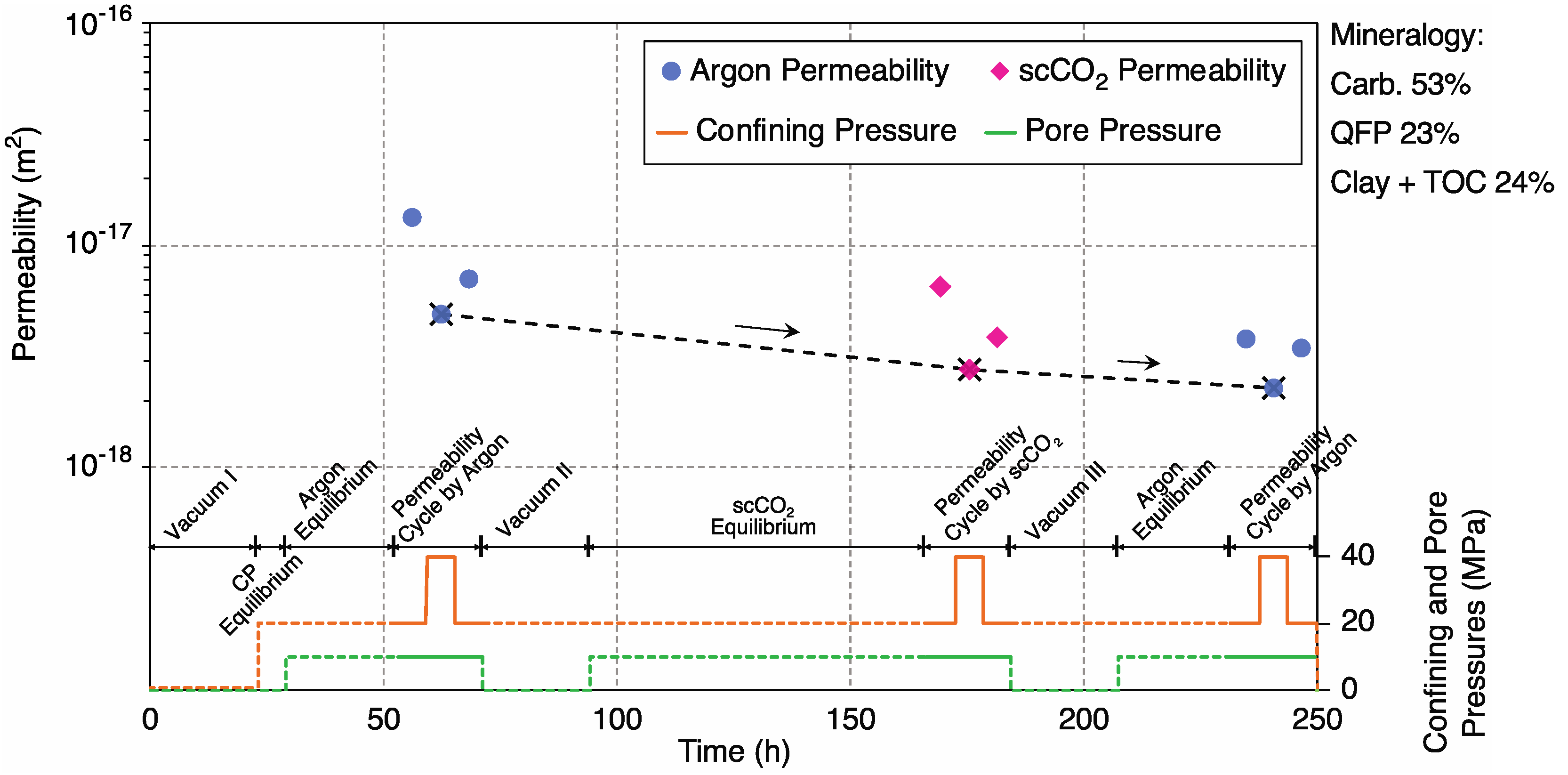
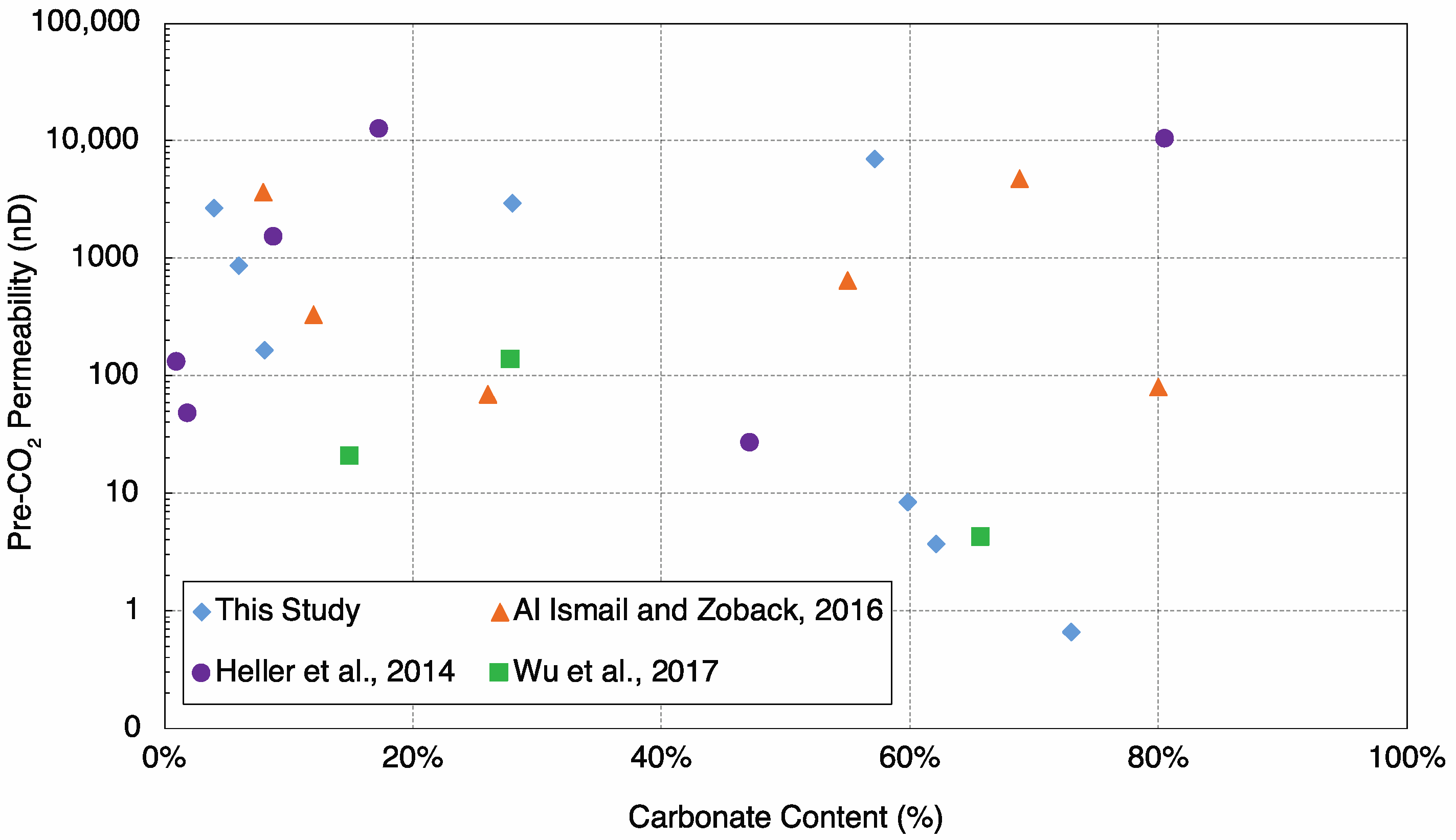


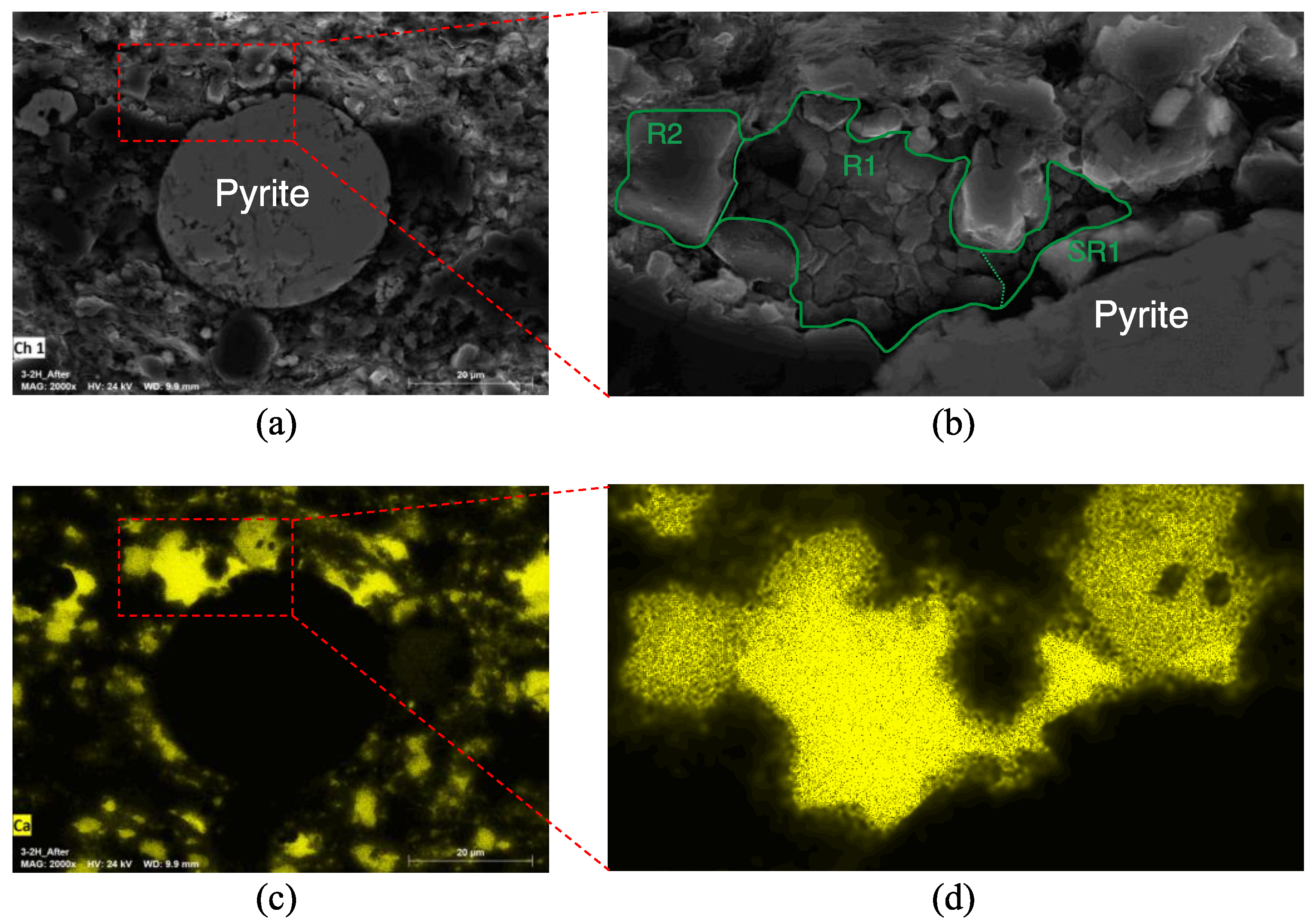

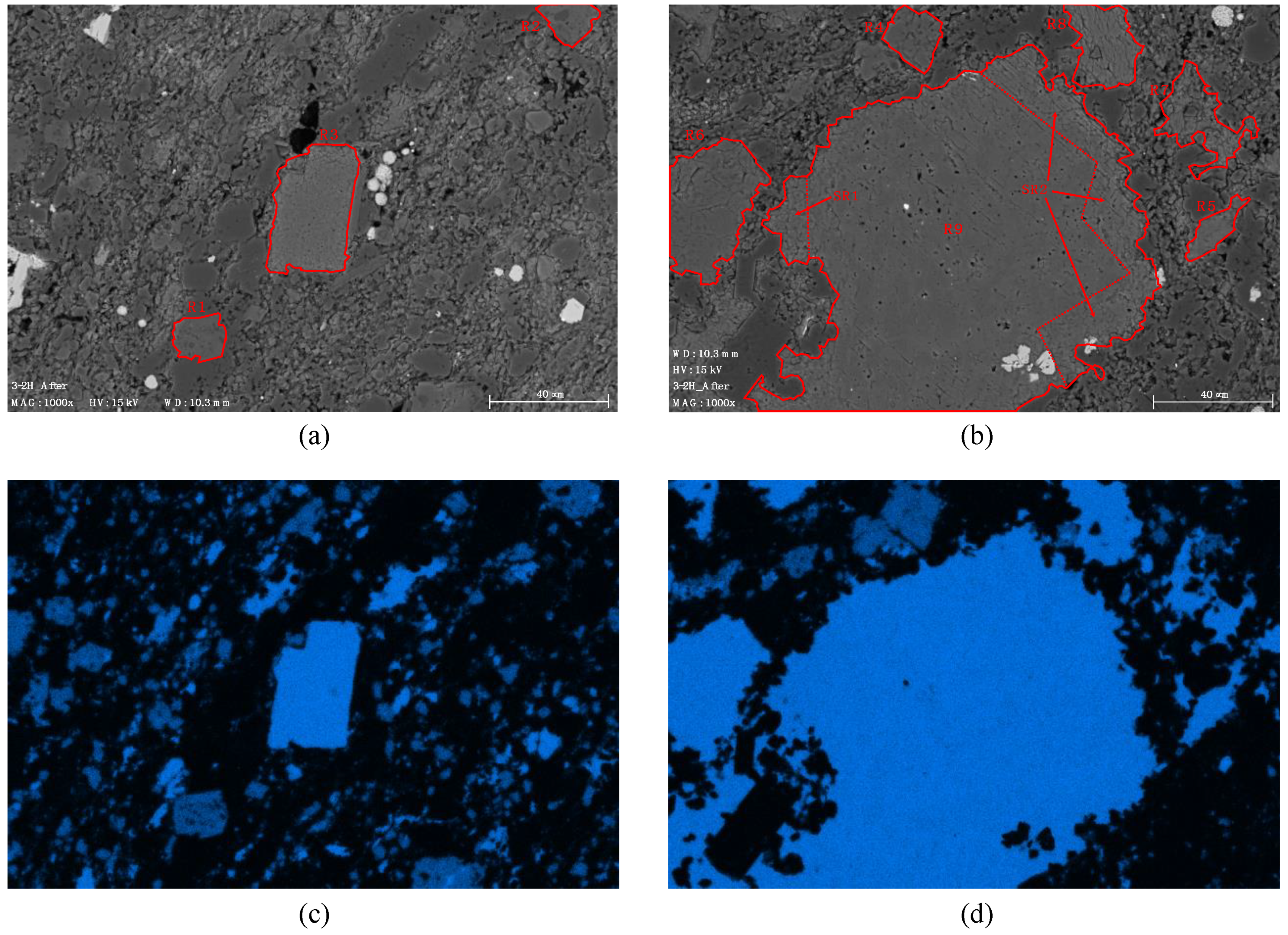
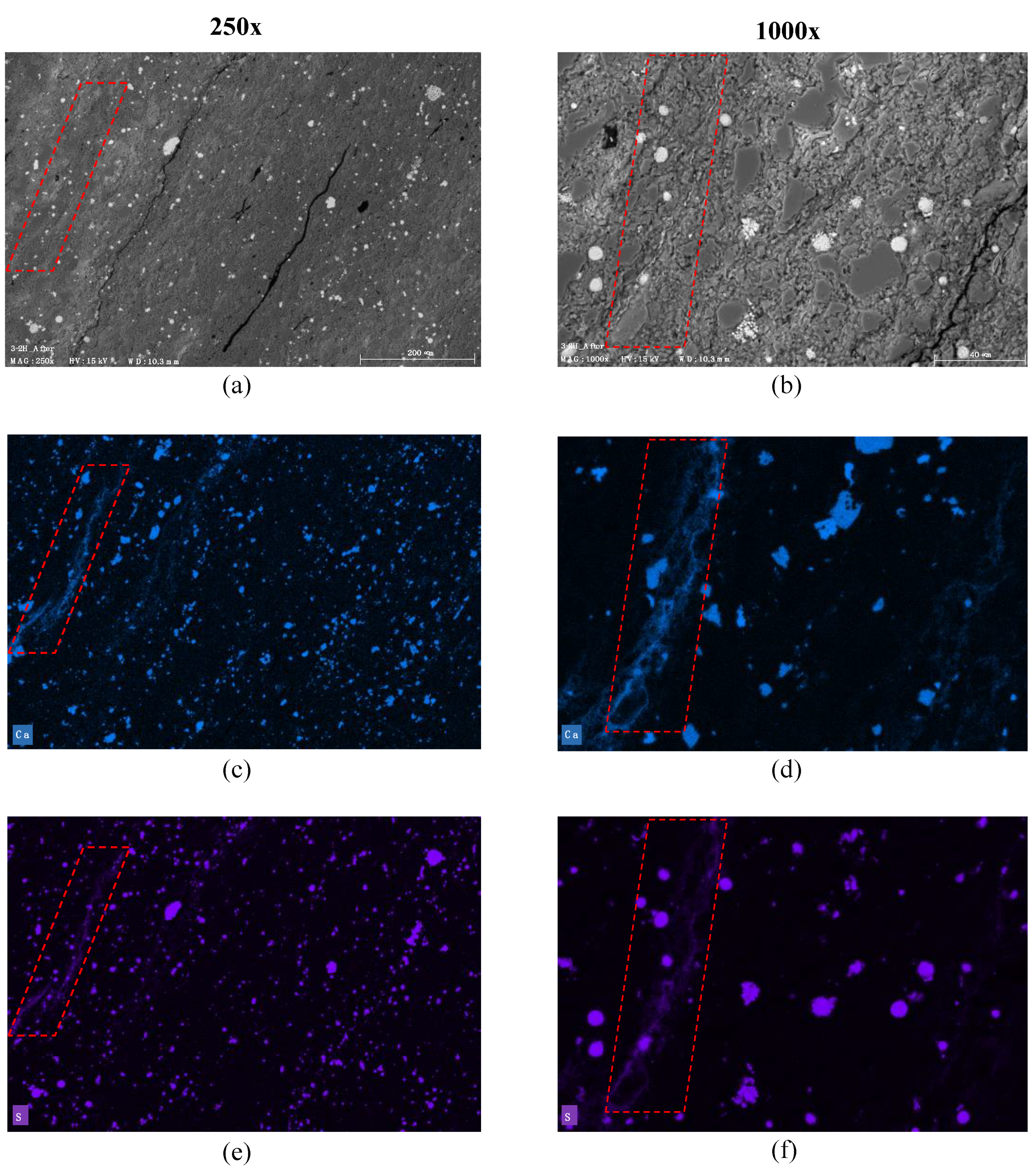
| Formation | Wolfcamp | Eagle Ford | Utica | |||||
|---|---|---|---|---|---|---|---|---|
| Sample ID | 2-1H | 3-2H | 4-2H | 4-4H | 1-63H | 3-110H | 4-6H | 1-42-3H |
| Diameter (mm) | 25.21 | 25.25 | 25.28 | 25.25 | 25.31 | 25.35 | 25.25 | 25.32 |
| Length (mm) | 9.55 | 8.02 | 6.62 | 7.32 | 6.06 | 6.41 | 6.03 | 7.34 |
| Depth (m) | 2859 | 2893 | 2943 | 2949 | 4281 | 4334 | 4348 | 1914 |
| Well Number | Sugg-A-171-6TW | Seidel-A-2MW | Lennington-1H/OH-HH-63992 | |||||
| Carbonate (%) | 71.5 | 3.9 | 5.8 | 3.6 | 55.8 | 56.9 | 53.1 | 15.3 |
| Calcite (%) | 71.5 | <bdl | <bdl | 1.1 | 55.8 | 56.1 | 53.1 | 15.3 |
| Dolomite (%) | <bdl | 3.9 | 5.8 | 2.5 | <bdl | 0.8 | <bdl | <bdl |
| QFP (%) | 27.7 | 67.9 | 61.8 | 52.5 | 21.3 | 21.5 | 22.8 | 32.9 |
| Feldspar (%) | <bdl | 7.2 | 7.2 | <bdl | <bdl | <bdl | <bdl | <bdl |
| Quartz (%) | 24.5 | 53.8 | 52.7 | 51.3 | 14.0 | 14.3 | 14.8 | 28.5 |
| Plagioclase (%) | <bdl | 11.0 | 7.2 | <bdl | 2.5 | 2.5 | 2.9 | <bdl |
| Pyrite (%) | 3.2 | 3.8 | 1.9 | 1.2 | 4.8 | 4.7 | 5.1 | 4.4 |
| Muscovite (%) | <bdl | 24.6 | 29.3 | <bdl | <bdl | <bdl | <bdl | <bdl |
| Illite (%) | <bdl | <bdl | <bdl | 39.5 | 9.7 | 8.5 | 9.9 | 47.2 |
| Mica (%) | <bdl | <bdl | <bdl | <bdl | 5.1 | 5.3 | 5.7 | <bdl |
| Chlorite (%) | <bdl | <bdl | <bdl | <bdl | 1.3 | 0.9 | 1.4 | <bdl |
| Total Clay (%) | <bdl | 24.6 | 29.3 | 39.5 | 16.1 | 14.7 | 17 | 47.2 |
| TOC (%) | 0.8 | 3.6 | 3.1 | 4.4 | 6.8 | 6.9 | 7.1 | 4.6 |
| S1 (mg/g) | 0.59 | 3.83 | 5.7 | 6.57 | 8.72 | 9.94 | 10.67 | N/A |
| S2 (mg/g) | 1.05 | 8.68 | 6.87 | 13.04 | 7.07 | 6.28 | 6.47 | N/A |
| S3 (mg/g) | 0.17 | 0.32 | 0.32 | 0.2 | 0.27 | 0.25 | 0.24 | N/A |
| Tmax (°C) | 442 | 444 | 445 | 446 | 350 | 470 | 479 | N/A |
| HI | 140 | 240 | 222 | 297 | 103 | 91 | 92 | N/A |
| OI | 23 | 9 | 10 | 5 | 4 | 4 | 3 | N/A |
| PI | 0.36 | 0.31 | 0.46 | 0.34 | 0.55 | 0.61 | 0.62 | N/A |
| Sample ID | Meas. Method | Initial Perm (m2) | kC2/kC1 | kC3/kC1 | Net Change | Processes/Phenomena |
|---|---|---|---|---|---|---|
| 2-1H | PD | 0.50 × 10−21 | 22.4 | 14.2 | Significant Increase | Irreversible dissolution of carbonate minerals (D) |
| 3-2H | SS | 2.08 × 10−18 | 0.49 | 1.01 | Constant | Reversible adsorption of scCO2 into clays and organic matter; Slight carbonate dissolution in micro-cracks (A) |
| 4-2H | SS | 0.76 × 10−18 | 4.50 | 3.25 | Significant Increase | Irreversible dissolution of calcite-filled micro-cracks (D);No observable adsorption despite high “clay+TOC” |
| 4-4H | PD | 1.47 × 10−19 | 0.52 | 0.95 | Slight Decrease | Reversible adsorption of scCO2 into clays and organic matter (A) |
| 1-63H | PD | 6.38 × 10−21 | 0.83 | 1.14 | Slight Increase | Dissolution dominates adsorption while both occur to a moderate degree (MAD) |
| 3-110H | PD | 3.08 × 10−21 | 0.55 | 0.84 | Slight Decrease | Adsorption dominates dissolution while both occur to a moderate degree (MAD) |
| 4-6H | SS | 4.87 × 10−18 | 0.57 | 0.47 | Decrease | Mechanical compaction of matrix surrounding micro-cracks overshadowing adsorption and dissolution (W) |
| 1-42-3H | SS | 1.97 × 10−18 | 0.30 | 0.45 | Decrease | Adsorption dominates over dissolution in both short and longer-term with enhanced dissolution in the latter (MAD) |
| Sample ID | Clay + TOC | (k10U-k30)/k10U × 100 | ||
|---|---|---|---|---|
| C1 Cycle; before scCO2 | C3 Cycle; after scCO2 | C6 Cycle; after Extended scCO2 | ||
| 2-1H | 1% | 25.3% | 41.5% | N/A |
| 3-2H | 28% | 23.5% | 26% | 27.3% |
| 4-2H | 32% | 13.1% | 11.6% | 9.2% |
| 4-4H | 44% | 10.8% | 6.7% | N/A |
| 1-63H | 23% | 25.1% | 21.9% | N/A |
| 3-110H | 22% | 17.8% | 0.73% | N/A |
| 4-6H | 24% | 30.6% | 33.4% | N/A |
| 1-42-3H | 52% | 33.3% | 45.7% | N/A |
Publisher’s Note: MDPI stays neutral with regard to jurisdictional claims in published maps and institutional affiliations. |
© 2021 by the authors. Licensee MDPI, Basel, Switzerland. This article is an open access article distributed under the terms and conditions of the Creative Commons Attribution (CC BY) license (http://creativecommons.org/licenses/by/4.0/).
Share and Cite
Kamali-Asl, A.; Zoback, M.D.; Kohli, A.H. Effects of Supercritical CO2 on Matrix Permeability of Unconventional Formations. Energies 2021, 14, 1101. https://doi.org/10.3390/en14041101
Kamali-Asl A, Zoback MD, Kohli AH. Effects of Supercritical CO2 on Matrix Permeability of Unconventional Formations. Energies. 2021; 14(4):1101. https://doi.org/10.3390/en14041101
Chicago/Turabian StyleKamali-Asl, Arash, Mark D Zoback, and Arjun H. Kohli. 2021. "Effects of Supercritical CO2 on Matrix Permeability of Unconventional Formations" Energies 14, no. 4: 1101. https://doi.org/10.3390/en14041101
APA StyleKamali-Asl, A., Zoback, M. D., & Kohli, A. H. (2021). Effects of Supercritical CO2 on Matrix Permeability of Unconventional Formations. Energies, 14(4), 1101. https://doi.org/10.3390/en14041101





